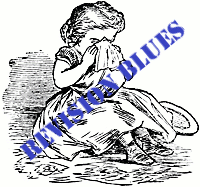 I have a nifty story
I have a nifty story
I wrote it yesterday
The problem now, I can’t see how
To rework it today–
Oh, I’ve got the revision blues (it happens every time)
Oh yes, the revision blues (it really is a crime)
I’ve got the revision blues
And I think I need some downtime.
Yes, I admit to owning (and abusing) a rhyming dictionary. I promise, no further verses of doggerel for at least another week.
They–the all-knowing they who proclaim great truths from on high–they say that if you manage to actually finish that first draft of a novel, then you’ve taken a significant, and, indeed, entirely necessary and critical step towards publication.
They, in this case, are correct. However, what “they” have failed to take into account is that I don’t seem to have a problem with the first draft part. I have no fewer than four separate manuscripts of YA novels in various stages of draft-dom. Where I have my issues is in revision.
Namely, when I sit down to revise, I often feel like I have no idea what I’m doing–that fancy three-letter graduate degree just sits there on my filing cabinet like an inanimate and unhelpful sheet of meaningless paper. Sometimes I revise–and revise, and revise again–only to feel completely uncertain if I’ve even made my work any better. In fact, sometimes I’m terrified that I’ve actually made it worse, and that I won’t be able to tell the difference. How do other writers cope with this? How can you tell when you should keep plugging away at a story, or if it’s time to put it aside, either temporarily or permanently?
I’m sure there’s no way to just magically know. (Though if there is, and you’re all keeping it from me…why I oughta….) But if you have any revision hints, or great links you’ve run across, strategies that work for you, I’d love to hear them!
A., I feel your pain! Two of my favorite places to find revision inspiration (or at least to productively procrastinate) are Laini Taylor’s Not For Robots and Darcy Pattison’s Revision Notes.
They are both rife with good ideas and strategies. Bon chance!
I think you have the right idea of writing your scene from a different angle, just to give yourself another way of looking at things — but what worked for me at long last this past summer/fall was to SCRAP EVERYTHING and start with a plain blank sheet. Knowing where I wanted to go — and walking there on a different path.
Next month we’re all over revision for Craft… Holly has two great ideas, I second visiting Laini’s site.
Hmmm.. it’s a different case with me, in that revising, at least of my first novel, was easy I just knew as I re-read what was to go and what I felt should stay or need even more emphasis.
But the significant changes that came in the proper editing made my own revision so insignificant hehe! All I know is that at the end I sat back and told myself, this is a good book now 🙂
When I was revising my first novel, I went chapter by chapter and made good use of an Excel spreadsheet – a row for each chapter with columns for chapter #, Status (more later on this), Major event(s), Emotional arc, my own revision notes, my critique group’s notes, and Action items.
For “Status,” I chose a color to indicate in what kind of shape the chapter was – green for great, yellow for ok, orange for uh-oh, and red for…red alert. This was probably the most useful thing – seeing that all the chapters weren’t that bad, and trying to figure out what made the green chapters good and getting the other chapters to that level.
Huh. Maybe I’ll blog about this sometime. 😀
Wow, Holly–that’s REALLY organized!! It sounds great. I might have to try a spreadsheet. I guess the part I’m having trouble with is the color-coding. I always feel like the chapters are yellow-green after I’ve revised them, and then slowly, over time, like the leaves, they seem to turn orange-red. 🙂
Not an author here, no tips, I’m sorry to say, but I just want to say I like your blues song and the image which accompanies it!
Ha – yes, but in an extremely messy way. 😉
I avoided the red chapters for a while – which were of course in the most critical places, then tried going backwards from the last chapter (that was a completely mental idea), then polished a few green chapters before finally diving into the red and orange ones…which were really terrible, hair-pulling excavations…and afterward, the yellow ones didn’t look half bad! So maybe doing a red chapter or two would be encouraging for the rest of your novel.
What always worked for me with every bit of writing I’ve produced so far is that I set a framework for my revision time. For example, I will spend two days revising and during this time, I must revise the whole thing (hopefully) more than once and (hopefully) improve it. At a certain point I have to stop myself. I’m pretty sure this will leave a few holes here and there, but that’s why this technique (if it could be graced with such a name) is useful for the first draft and not, say, for the final draft.